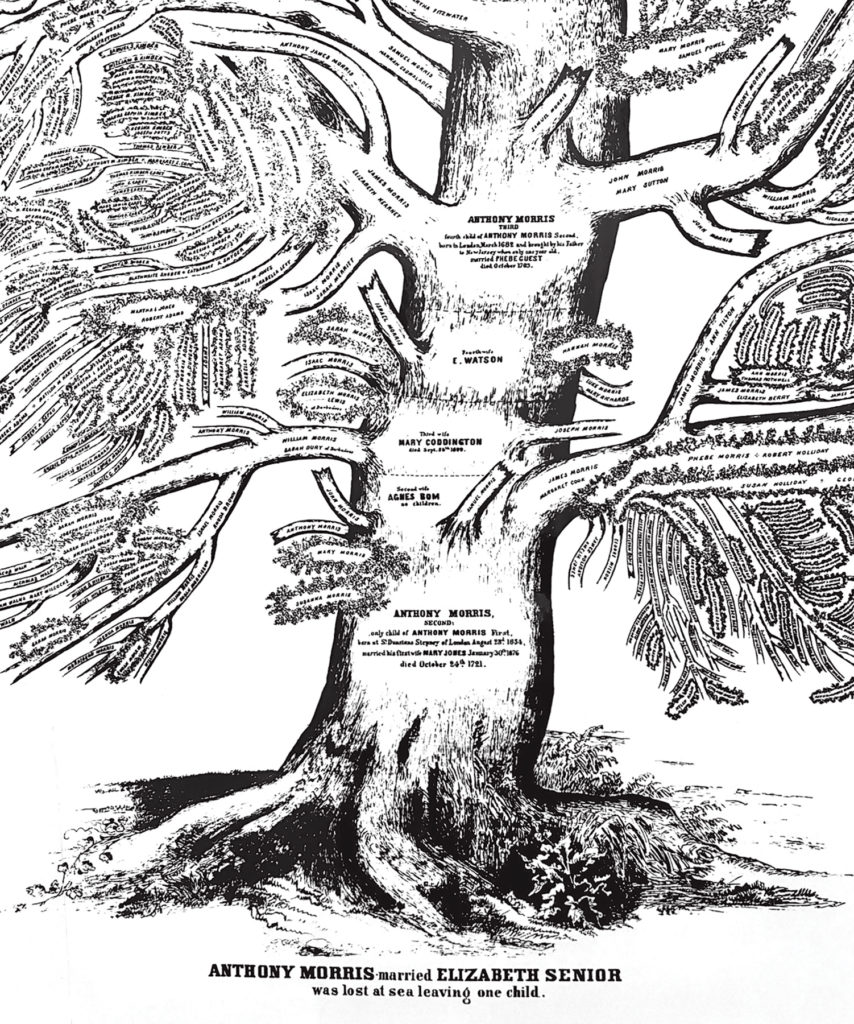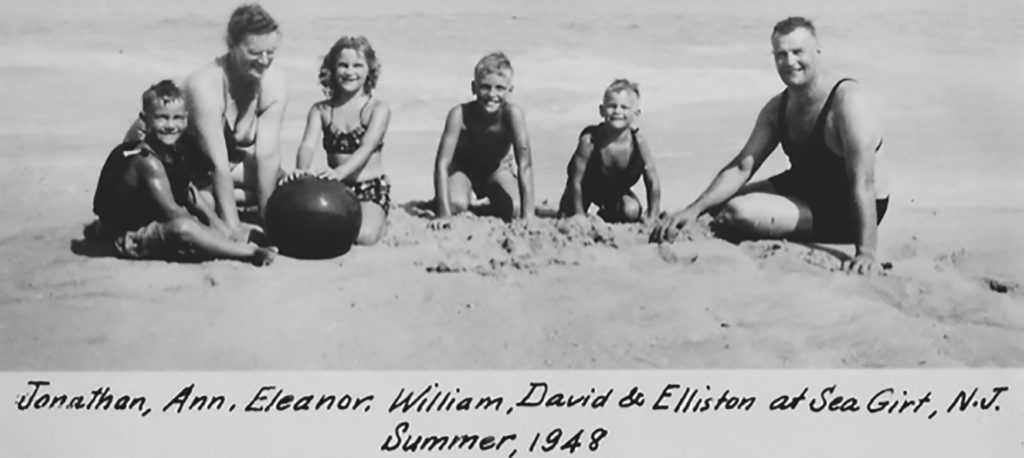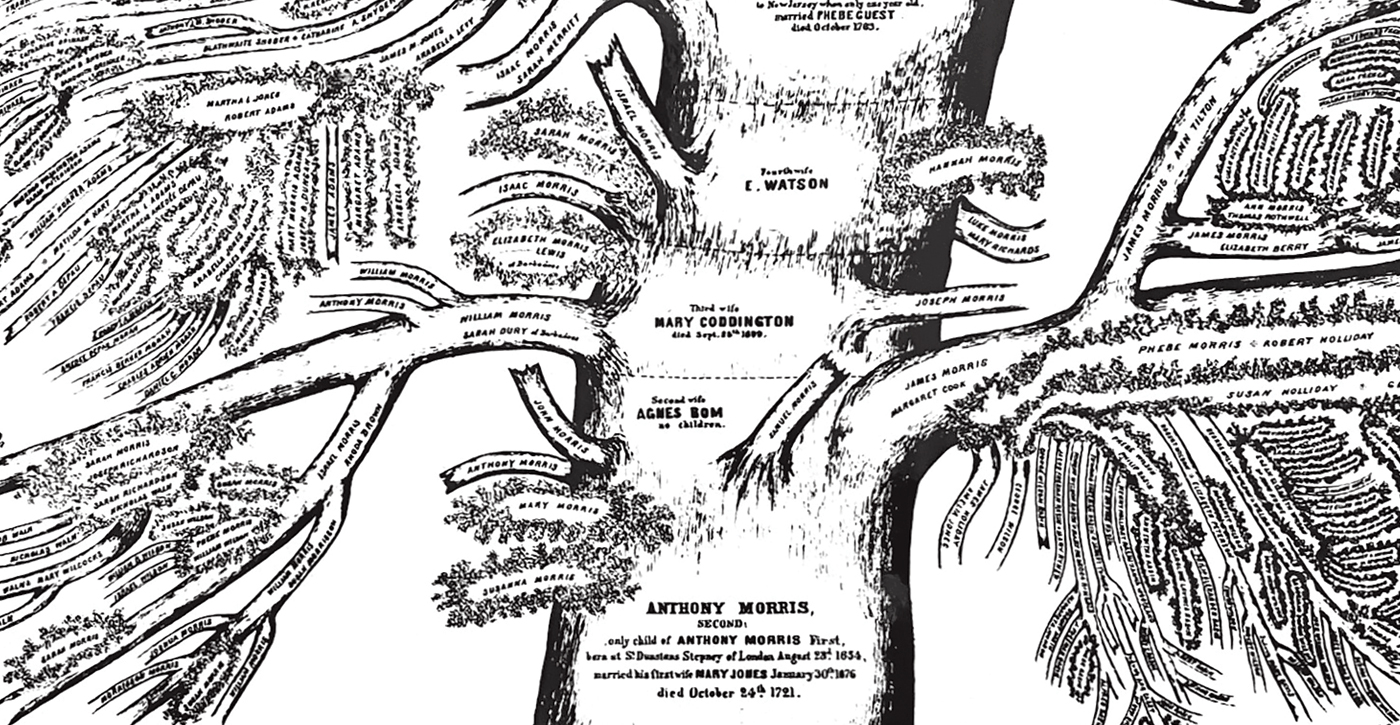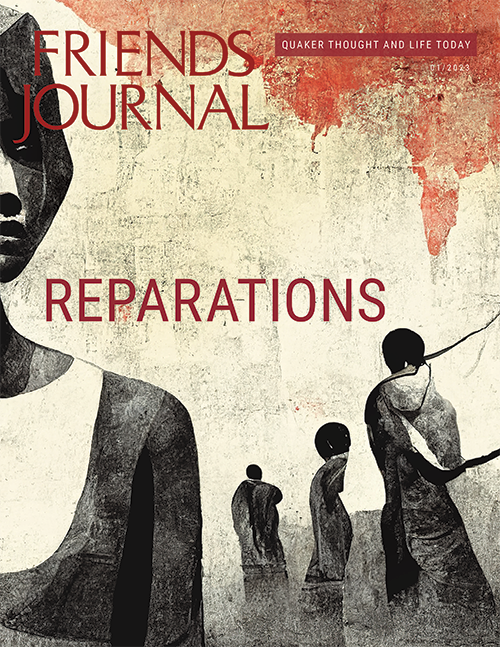A Search Through One Family’s Genealogy
Eleanor and I come from one of the Morris families who helped build Philadelphia. We are descendants of Anthony Morris, a Quaker who emigrated with his wife and infant son from London, England, to the new colony of Pennsylvania.
In the past decade, we have felt an increasingly clear call to explore our individual racism and to research it in the history of the Morris family. We have found 20 names in public records of Black individuals our ancestors enslaved; there may have been more.
Our parents, Elliston Perot Morris and Anna Sayler Morris, both deceased, raised us within the Religious Society of Friends, under the care of Southampton (Pa.) Meeting, part of Bucks Quarterly and Philadelphia Yearly Meetings. Eleanor is now an active member of Asheville (N.C.) Meeting, part of Southern Appalachian Yearly Meeting and Association (SAYMA). I, David, am not a member of a local meeting, yet hold to Quaker core beliefs.
Eleanor: Our parents modeled a personal involvement with racial justice concerns: being founding members of an intentional cooperative community where all “races” were welcome; welcoming into our home an elderly Japanese man when he was released from a Japanese internment camp; and providing a temporary refuge for the first Black family to buy a home in Levittown, Pennsylvania, when dealing with harassment was overwhelming. Other adults around us demonstrated in their lives commitment to creating a more just and loving society. Raymond Wilson, the first executive secretary of Friends Committee on National Legislation, was a member of our intentional community, and several members of Southampton Meeting worked for American Friends Service Committee.
I suppose this presents our standing as lifelong Quakers and our current meeting status. “Standing” is a significant concept in this family history reflection. So too are the actions we and our ancestors have taken as Quakers—or neglected to take—that have caused harm, intended or not, to our fellow human beings. Both are part of the Quaker legacies we have received and will pass on, after our contributions, to those who follow. We imagine other Quakers are exploring their version of this story. If not, perhaps this is the right time to stand up in the swirling, sea-changing currents that define our social disorder: to choose restorative paths toward antiracist realignments.

Family tree for Anthony Morris, a Quaker who emigrated from London, England, to the new colony of Pennsylvania
in the 1650s.
The family tree that Anthony Morris planted is extensive. They were prominent within Philadelphia Yearly Meeting, as well as in city, colonial, business, social, and civic circles (we are not directly related to Robert Morris, the financier and signer of the Declaration of Independence). They had various enterprises and homes in the city and surrounding Chester, Montgomery, and Bucks counties. They held positions of authority, filling social and economic roles that helped build William Penn’s “peaceable kingdom.” As Morris children, we were raised to think of our ancestors with pride. Their religious and civic lives were glowingly described in family history books. We were taught stories about Philadelphia Quaker abolitionists: early leaders in colonial movements to abolish slavery.
In the first five generations, our Quaker family purchased or were gifted enslaved individuals. We have only an inventory of enslaved individuals, along with other property for transfer purposes, listed in wills, deeds, or manumission papers (written documents officially freeing enslaved individuals, signed by the enslaver). Our ancestors most likely held them for domestic service and as laborers in their businesses.
Some continued to hold their enslaved “servants” until 1776, when Philadelphia Yearly Meeting required Friends to stop slaveholding, if they wished to remain in good standing as Friends. Those were turbulent times within the Society of Friends: there was a long period of struggle to regain a standing balance and establish new norms.
Most of the enslaved laborers were mentioned in documents only by their first name. It begs many questions: When and where were they born? Who were these enslaved peoples’ parents and siblings? Where did they live and what did they do? How did they come to be held in bondage? How did they relate to the Morris ancestors who enslaved them? Who were their marriage partners or companions? Who were their children or grandchildren? When did they die, and where are they buried? Who honors their memory?
Eleanor: The discovery that our ancestors had been slaveholders, along with increasing attention being called to the unwelcoming aspects of many of our Friends meetings, were triggers for me to look beyond my comfortable life. Thus far, it has been a journey of reading, listening, and opening up to the experiences of those beyond my personal environment. However, I am aware that mostly it is my knowledge that has expanded, and I have been resisting the heartfelt identification with the experience of the Black community that might lead to more active and passionate work for racial justice. I hear a Black social activist admonishing White people for lingering in the information-gathering stage when they are needed to be “doing” allies for Black people, because “My people are dying!”
We were raised to think of our ancestors with pride. Their religious and civic lives were glowingly described in family history books. We were taught stories about Philadelphia Quaker abolitionists: early leaders in colonial movements to abolish slavery . . . [but] in the first five generations, our Quaker family purchased or were gifted enslaved individuals.
Our intent is not to vilify our ancestors. As Harriet Tubman said, “I think there’s many a slaveholder’ll get to Heaven. They don’t know better. They acts up to the light they have.”
As early as 1682, there were Quakers testifying that slavery was wrong. They urged Friends to look toward that Light. It seems our ancestors did not attend to these prophetic testimonies. Anthony Morris shows up in Marcus Rediker’s biographical book The Fearless Benjamin Lay as a Friend who denounced the Quaker abolitionist as a troublemaker and actively legislated laws to “control” both freed and enslaved Africans in Philadelphia in the 1700s.
Our ancestors were doing the best they could with the Light they had; we see no added insight to be gained by judging them by today’s ethical standards. We are, however, asking ourselves a fundamental query: What norms are we perpetuating because we are not sensing the Light shining on our own biases in our own times, specifically our racism? We wonder what we are listening to now, instead of following our own gifts of inner stirrings to learn about antiracism and interracial healing steps.

Elliston and Ann Morris family photo, Sea Girt, N.J., summer 1948.
Generational wealth and privilege
Part of their foundational legacy to us includes financial privilege. Our ancestors were merchants; they accumulated wealth. Upon their deaths, they gifted their children a portion of their wealth. That inherited wealth tradition has been maintained in each generation since. Our grandchildren are the twelfth generation in the Morris family line. These financial privileges are so woven into our daily lives, we need to step out of our own routines to even see them.
We and our siblings have benefited from these wealth legacies. We are grateful, yet we took it for granted, as if we were entitled to it. Our private Quaker high schools as well as college education costs were subsidized; our establishing initial housing and career-enhancing opportunities were all financially supported.
To varying extents, we each have continued these traditions of generational wealth management. From our parents’ generation, on through ours, and to our offspring’s, vocational choices mostly have turned from commerce to human services with the resulting diminishment of income expectations. Yet the historic patterns persist; wealth inheritance continues. Money management structures extend and pass the privileges along to the next generation.
It is true that part of that legacy was the value of generous charitable giving. Previous generations have established and/or funded notable public and social service organizations. This generosity came from a paternalistic perspective of White superiority, and righteousness; a beneficent sharing from those who had earned much with those less fortunate. These charitable actions were not reparations. Our ancestors did not believe racial violence and injustice started with their own business and social practices. As their descendants, most of our extended family have continued in this mindset.
Left: David Morris with his grandfather Marriott Canby Morris Sr., on the beach in Sea Girt, N.J., 1946. Right: Elliston P. Morris Jr. on the beach with waves rolling in nearby, Sea Girt, N.J., 1911.
Sharing with the extended family
In 2019, we gathered our siblings with children and grandchildren for a week’s family reunion. It was held in the Philadelphia area so that we could tour some of our family’s history sites. This was a first experience for many of our extended family. They have lived all their lives elsewhere in the world. It was also an opportunity to introduce our thinking about slaveholding as a critical part of our ancestors’ history. We broached the notion of reparations in our current times.
We emailed an overview of our genealogical research to members of our extended family, including the documented names of enslaved African people held by our ancestors. There were no responses. In subsequent conversations with some of our relatives, I heard that, though they are interested in these new insights, they were wary of considering a path toward reparation.
Eleanor: I have come late to the need to respond to the racism in our society and my own White privilege, so I am sympathetic to those who have not yet felt that need. I am also aware that there are many challenges in our society that need work, and no one person can focus on them all. We are all at different places along our journeys. “It takes a village,” and we can each work on issues in ways that fit our skills and inclinations. So, in sharing what is calling me, I want to respect what another is, or is not, called to. Why, in spite of my early exposure to the impact of racial discrimination, had I not felt a personal responsibility to do anything about it? I just assumed that I was a “good White person,” because I have had Black friends and contributed financially to organizations that worked on racial justice issues.
It seems part of our reparation preparation at this point will be helping our family members shift from negative feelings about reparation to a more positive perspective. It would be one associated with repairing, rebuilding, restoring, reforming, reuniting interracial relationships, and stepping into a frame of reference that inspires hope for justice. It would form a platform for creative restitution through cooperation and shared insights.
Eleanor: Many of the folks with whom I have talked about my increasing understanding of my White privilege and institutional racism have indicated they were not aware of the repercussions for Black people resulting from this historic wrong. Some have complimented me for giving attention to racism and its impact, but then said that it is not something in which they want to be involved. However, as I have shared my experience, some have been encouraged to learn more and to examine their own lives.
I have found connecting with others who are on their own paths of engaging with the implications of racism to be both enlightening and supportive. My initial group participation in the 2020 Pendle Hill workshop “Race, Reparations & Right Paths”; the weekly Racial Justice Discussion Group of Asheville (N.C.) Meeting; and discussions at SAYMA have all challenged me to ponder more deeply my own attitudes and beliefs. Two ideas from the Pendle Hill workshop have been especially meaningful to me: one is to approach this work from a sense of “justice,” rather than from “guilt” (my habitual starting point); the other is an awareness of the many different understandings of what “reparations” mean, and of the many different paths toward it.
White families bear a financial and logistical responsibility to help Black families research their ancestors, and can help build strong generational documentation in ways the Black genealogy community endorses as relevant.
Supporting Black families in discovering their family trees
In addition to the personal and family-level focus, a second path toward social and racial balancing is leading us to help close a gap in the genealogical research circles. The African American Genealogy Group (AAGG) of Philadelphia is one organization closing this gap. They are helping Black families find ancestors and build strong family trees.
Another example is Haverford College Libraries (near Philadelphia) digitizing manumission papers in their Quaker collections. These documents were created and saved by families and meetings in the Philadelphia area between 1765 and 1790. This database is just the first step in researching who these liberated people were. Further research is time-consuming. It requires administrative organization and oversight, financing for internships, accommodating visiting genealogists, and other research costs.
The 339 Manumissions and Beyond Project is a research and education initiative that acts as a community liaison for the Haverford College Libraries Quaker and Special Collections and their digital scholarship staff. (The project is independent of the college and library.) As this group establishes its organizational structure, it too will likely need funds to further its work.
Contributing archival letters, journals, and meeting minutes and literature about what individual families or meetings did to aid their freed “servants” would be critical to discovering what happened to them: what names they chose, if different than those written in the manumissions papers; where they lived; who they associated with; how they made a new life for themselves; where and when they died; what descendants did they have; and what is known about them over the years. These artifacts may still be in family attics and basements.
It was our White ancestors who withheld from enslaved Black ancestors reading, writing, and other educational privileges; broke up family generational continuities; blocked Black people from gaining generational wealth; withheld rights to post births, deaths, marriages, social associations, business transactions, and wills in public registries. They could not publish volumes of family histories for their descendants to read. As White people, we are the ones responsible for this genealogical research inequity. It is time to share in the process of closing that gap.
White families bear a financial and logistical responsibility to help Black families research their ancestors, and can help build strong generational documentation in ways the Black genealogy community endorses as relevant. When asked, we can assist in ways they suggest are most useful. This is the repair and rebuilding of a system of data-keeping that has long been denied Black descendants of their enslaved ancestors.
Our country’s foundations were built by a violent, colonial plantation system; there was exploitation in the name of king, country, and personal gain. Both Indigenous native tribes and kidnapped people of African descent were and are now being damaged. The wounds and trauma have been inflicted by the social system designed and sustained by people of European descent. Throughout U.S. history, the efforts of People of Color to resist this arrangement were and are tenaciously suppressed. To right these wrongs, restitution is needed.
These possibilities toward reparation that Eleanor and I are pursuing, as way opens, are modest. We are eager to proceed without letting frequent waves of missteps, disappointments, and fatigue knock us down. We believe, pray, and trust that each of us will find remedial changes we can make in our own lives, families, friendship circles, and local communities. Please consider our ongoing story as encouragement for each of you to find your own restorative footing, stand firmly in the growing social turbulence, and step boldly into creating a more just future shared by all of God’s creation.






While doing research on Speightstown in Barbados I came across the descendants of Anthony Morris. In 1908, Dr. R. C. Moon came to Barbados to do genealogical research on families in Philadelphia who had Barbadian connections. He published his findings in three Volumes entitled The Morris family of Philadelphia, descendants of Anthony Morris, born 1654-1721 died.
My researches lead me to conclude that practically every family appearing on the 1675/80 Ford Map of Barbados was a Quaker family.
There was at least one Morris family here in Barbados, a Colonel Lewis Morris, who brought Judge Ralf Fretwell to a Meeting at the “Bridge” to hear George Fox in 1671 when he visited. The Judge became convinced at this meeting and began having meetings to share the Word of God with slaves. Unfortunately, there was a law passed in 1676 forbidding Quakers having slaves at their meetings, the penalty being a fine payable on each slave present.
The person who exposed him for having 80 slaves at his meeting in 1677 was another Quaker, Thomas Cobham!! The episode is in Besse.
The Judge was forced to swear an oath of allegiance which he would not and lost his post. Those who sat in judgment were themselves Quakers!! I explain it by saying that there was a law and those responsible for its enforcement did their duty,
Ralph Fretwell bought land in Pennsylvania when it became available and made it available to Barbadian Quakers for purchase. He died in 1701.
Lewis Morris, who had no children, eventually emigrated to New York after his brother, Richard died and raised his nephew, also Lewis Morris. His nephew became the Governor of New York and his nephew’s son, also Lewis Morris, was a signatory to the Declaration of Independence.
I am a descendant of both Quakers and slaves. Ancestors of mine appear in Besse as well, William and Geoge Ashby. In 1676, William Ashby, a stone mason, spent Christmas Day in the Stocks for working on a holy day!
To this day there is a Senior’s Plantation in existence in Barbados and Jones is a common surname with several Jones families appearing on the 1675/80 Ford Map.
I often wondered if any of the Jones families who settled here in Barbados were relations the Christopher Jones, the Master of the Mayflower.
Thx for this thoughtful article. As a fellow Quaker and Morris descendent, in possession of a cupboard full of family bibles from one of the Anthony Morris’s and Margaret Moon, I had noticed hints of slave ownership in some older wills I’d seen on Ancestry’s website. I remember seeing among the furnishing left to a beloved wife, “my man Samuel” – Probably not a paid employee I thought. So one Anthony Morris endorses the Germantown Edict but another Anthony Morris co-authors the Pennsylvania Slave Code. And a later Anthony’s daughter Sarah, my second great grandmother is active in abolitionist work.
Here in Maryland, Woodlawn Manor House was owned by Quaker Dr. William Palmer, his second wife inherits enslaved people, he does not release them until forced to at the end of the civil war, he is removed as a member of Sandy Spring Friends Meeting for holding slaves, but is buried in the graveyard nevertheless.
And lets not even think about the young women I met several years ago while working with an NPR crew in India, who had been sold to a brothel, one by her parents, and the other by her husband’s family. Contradictions abound, ignoring the one true light we should all have within- one does not enslave or encumber the freedoms of other human beings.
Hello Eleanor and/or David….
Are you the Morris family that lived on Gravel Hill Rd., South Hampton ,PA?…or
related to them. ? I met David in the 60’s in SC when he and I were at Claflin College
in Orangeburg. SC. …… many years ago, but so fondly remembered…. some we always remember for various reasons…..
David I never forgot……. if you are of the same family or know where David is living ……. would you please share the
information. He is on my bucket list, and I would love to just say hello. He knew me as “Kitten”.
Thank you very much…
Linda Goble Cox
(905) 639-4756
Greetings! Glad to hear of the Quaker Morrises who apparently had land in both Chester and Montgomery Counties. I have long been looking for my ancestor Elizabeth Morris (1752-1836), a Quaker, who married a Mennonite, George Bechtel, from close to Pottstown. Any clue into which branch of your Quaker Morrises might have belonged? I would be interested in hearing more about your research. My contact details are Peter Hoover
I researched my family name (Morris) and I am a decedent of Anthony Morris. My grandfather was Rose Timothy Morris. I live in Alabama.
Vanessa Morris